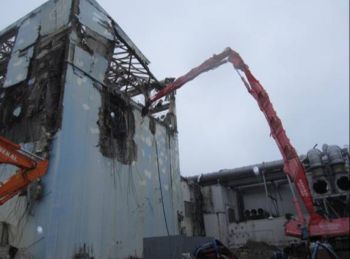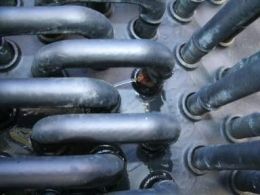
Publisher:
Bonnie King
CONTACT:
Newsroom@Salem-news.com
Advertising:
Adsales@Salem-news.com

~Truth~
~Justice~
~Peace~
TJP
May-07-2012 13:31


 TweetFollow @OregonNews
TweetFollow @OregonNews
Fukushima Daiichi Site: Cesium-137 Is 200 Times Greater Than At Chernobyl Accident
Salem-News.comBegins with Urgent Request on UN Intervention to Stabilize the Fukushima Unit 4 Spent Nuclear Fuel
 Reactor 4 during debris removal. Courtesy: enformable.com |
(WASHINGTON DC) - We have brought our readers many stories about the damaged Fukushima nuclear facility in Japan, where dangerous levels of radiation will possibly spike by several times if corrective measures are not taken very quickly.
 Close up of Fukushima Reactor 4 |
This is important news that affects all people on earth. It could not be more serious in nature. Interestingly, it is Oregon's U.S. Senator Ron Wyden who brought the heightening issues surrounding this problem to light in recent weeks.
We have been building information for this piece, and then today we received this urgent appeal from Japan.
Please read all of the associated information and share it to the best of your ability.
| “ |
Nearly all of the 10,893 spent fuel assemblies at the Fukushima Daiichi plant sit in pools vulnerable to future earthquakes, with roughly 85 times more long-lived radioactivity than released at Chernobyl. Nuclear experts from the US and Japan such as Arnie Gundersen, Robert Alvarez, Hiroaki Koide, Masashi Goto, and Mitsuhei Murata, a former Japanese ambassador to Switzerland, and, Akio Matsumura, a former UN diplomat, have continually warned against the high risk of the Fukushima Unit 4 spent nuclear fuel pool. US Senator Roy Wyden, after his visit to the Fukushima Daiichi nuclear power plant on 6 April, 2012, issued a press release on 16 April, pointing out the catastrophic risk of Fukushima Daiichi Unit 4, calling for urgent US government intervention. Senator Wyden also sent a letter to Ichiro Fujisaki, Japan’s Ambassador to the United States, requesting Japan to accept international assistance to tackle the crisis. We Japanese civil organizations express our deepest concern that our government does not inform its citizens about the extent of risk of the Fukushima Daiichi Unit 4 spent nuclear fuel pool. Given the fact that collapse of this pool could potentially lead to catastrophic consequences with worldwide implications, what the Japanese government should be doing as a responsible member of the international community is to avoid any further disaster by mobilizing all the wisdom and the means available in order to stabilize this spent nuclear fuel. It is clearly evident that Fukushima Daiichi Unit 4 spent nuclear fuel pool is no longer a Japanese issue but an international issue with potentially serious consequences. Therefore, it is imperative for the Japanese government and the international community to work together on this crisis before it becomes too late. We are appealing to the United Nations to help Japan and the planet in order to prevent the irreversible consequences of a catastrophe that could affect generations to come. We herewith make our urgent request to you as follows: 1. The United Nations should organize a Nuclear Security Summit to take up the crucial problem of the Fukushima Daiichi Unit 4 spent nuclear fuel pool. 2. The United Nations should establish an independent assessment team on Fukushima Daiichi Unit 4 and coordinate international assistance in order to stabilize the unit’s spent nuclear fuel and prevent radiological consequences with potentially catastrophic consequences. 30 April 2012 Endorsed by: |
” |
Background on Reactor #4
"Fukushima reactor No. 4 vulnerable to catastrophic collapse; could unleash 85 times Cesium-137 radiation of Chernobyl; human civilization on the brink."
That is one hell of a headline, and I believe the team at NaturalNews said it well when they wrote:
"The news you are about to read puts everything else in the category of 'insignificant' by comparison". Experts have revealed that Fukushima reactor No. 4 is on the verge of a catastrophic failure that could unleash enough radiation to end human civilization on our planet. (See the numbers below.)
- The resulting releasing of radiation would turn North America into a "dead zone" for humans... mutated (and failed) crops, radioactive groundwater, skyrocketing infant mortality, an explosion in cancer and infertility... this is what could be unleashed at any moment from an earthquake in Japan. Such an event could result in the release of 85 times the Cesium-137 released by the Chernobyl catastrophe, say experts (see below). And the Chernobyl catastrophe made its surrounding regions uninhabitable by humans for centuries.
Yet, astonishingly, the usual suspects of deception are saying absolutely nothing about this problem. The mainstream media (the dying dinosaur media, actually) pretends there's no problem with Fukushima. President Obama says nothing about it. Federal regulators, including the NRC, are all but silent. It's as if they think their silence on the issue somehow makes it go away.
Helen Caldicott, MD: a Physician, Author and Public Speaker, says, "Few people know that the Pacific Northwest got whacked hard by fallout from the Fukushima disaster with radiation rates hundreds of thousands of times higher than normal background radiation. The damage from this is not something that the corporate media or the government is talking about. It mysteriously disappeared from the radar almost immediately".
Dr. Caldicott referred to this as a process of “cover-up and psychic numbing.” Looks like it may be working. In April, the Nuclear Regulatory Commission approved two new nuclear power plants in South Carolina, in addition to the two approved earlier this year in Georgia.
Dr. Caldicott talks about the dangers and hidden costs of nuclear power then tells the awful truth in minute detail about the actual scale of the Fukushima disaster and compares it to the nuclear disasters of Chernobyl and Three Mile Island.
Recent studies estimated that a million people have died so far from Chernobyl. Dr. Helen Caldicott is a physician, Nobel Peace Prize winner, noted author, anti-nuclear power advocate and has founded numerous national and international groups which oppose nuclear power & weapons, including Physicians for Social Responsibility."
Visit:
http://www.fukushima311watchdogs.org/share.php?partager=328
http://www.naturalnews.com/035789_Fukushima_Cesium-137_Plume-Gate.html#ixzz1u8Ew2kjh
Articles for May 6, 2012 | Articles for May 7, 2012 | Articles for May 8, 2012


Quick Links
DINING
Willamette UniversityGoudy Commons Cafe
Dine on the Queen
Willamette Queen Sternwheeler
MUST SEE SALEM
Oregon Capitol ToursCapitol History Gateway
Willamette River Ride
Willamette Queen Sternwheeler
Historic Home Tours:
Deepwood Museum
The Bush House
Gaiety Hollow Garden
AUCTIONS - APPRAISALS
Auction Masters & AppraisalsCONSTRUCTION SERVICES
Roofing and ContractingSheridan, Ore.
ONLINE SHOPPING
Special Occasion DressesAdvertise with Salem-News
Contact:AdSales@Salem-News.com

Salem-News.com:

Terms of Service | Privacy Policy
All comments and messages are approved by people and self promotional links or unacceptable comments are denied.
[Return to Top]
©2025 Salem-News.com. All opinions expressed in this article are those of the author and do not necessarily reflect those of Salem-News.com.